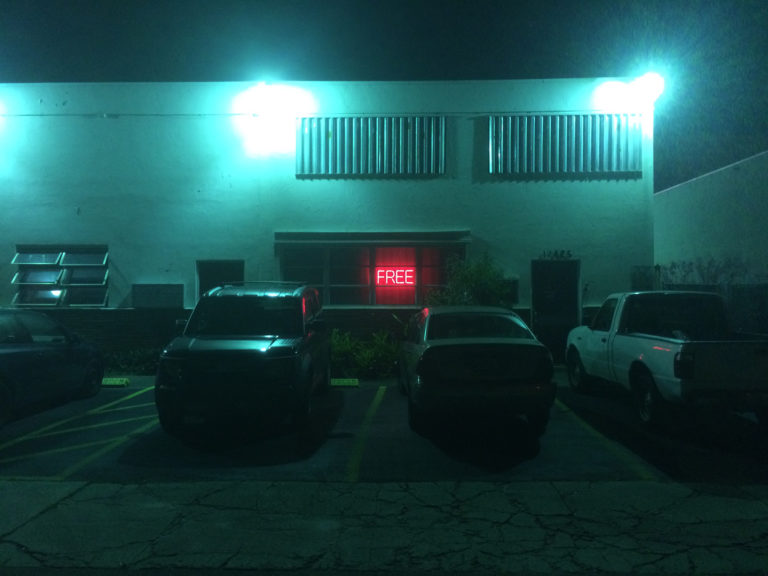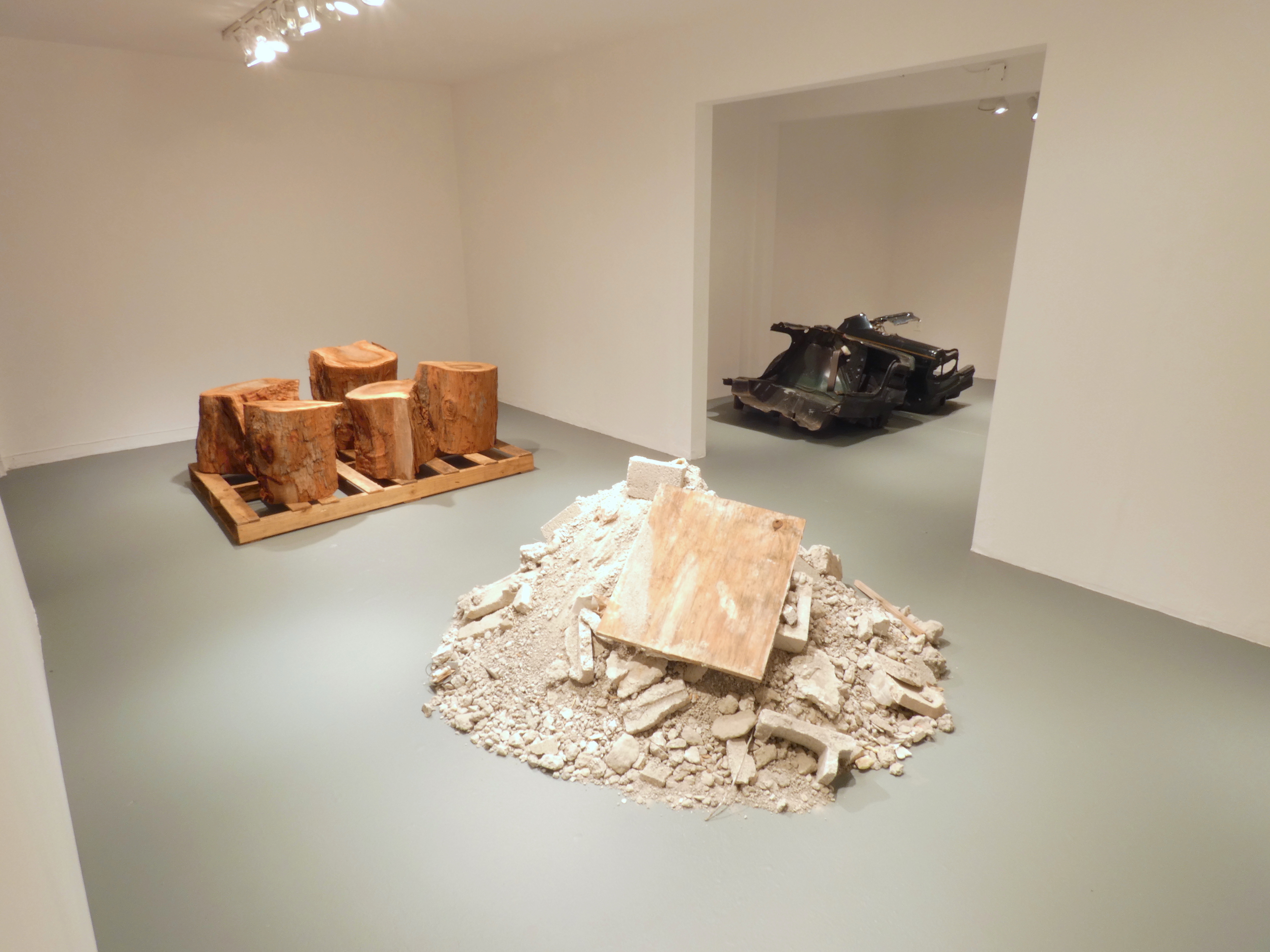Tom Scicluna: FREE at Under the Bridge

January 28-March 18 at Under the Bridge, 12425 NE 13th Avenue, North Miami, FL. Closing reception Sunday March 18 at 3pm.
Tom Scicluna practices a particularly austere brand of site-responsive art making. A typical installation consists solely of readymade objects and materials, often ones he finds already lying around or directly outside the exhibition space, which he simply arranges into new configurations. Despite or maybe thanks to this extreme degree of self-imposed limitation, he consistently manages to create memorable situations and effects.
Scicluna’s penchant for animating that which lies inert is in full force in FREE, his current exhibition at Lou Anne Colodny’s North Miami venue, Under the Bridge. Scicluna sourced most of the objects and materials that comprise the project from the “**FREE**” section of the local listings on Craigslist.org. The items he collected include a beat-up flat screen TV, a pair of car fenders, a pile of drywall dust and cinder block fragments, a group of cut logs, and other pointless stuff, all pertaining to a relatively rare category of thing: that which bears negative value. Worse than worthless, these objects were deemed not just unworthy of occupying space but also unworthy of the modicum of wherewithal that their prior owners would have had to muster to dispose of them themselves. (Free stuff on Craigslist usually comes with the caveat that one must have one’s own truck with which to haul it all away.) Within a capitalist, utilitarian society, these are the saddest of things, zombie things that linger around even as their owners can’t be bothered with how they might be monetized, put to good use, or even just discarded. Within the rarified context of a contemporary art space, though, they are transformed. The pattern of shattered glass and digital splatter on the face of the flatscreen (FREE 70” VIZIO HDTV- NEEDS PARTS – MUST HAVE TRUCK TO PICK UP (Miami Shores), 2018) suddenly appear painterly here, like an abstract-geometric composition… a pretty decent one. A crossfire of art historical references emerges, riffing off Richard Serra, Donald Judd, Carl Andre, Gordon Matta Clark… That the confluence of this pantheonic boys’ club with such value-less things should appear so natural harks back directly to the mythic ideological origins of site-specificity, with its subtext of resistance against the commodification of the art object. In Scicluna’s hands this association rings out most clearly in Free Paint (allapatah), 2018, which originally consisted of a few half-depleted cans of, well, free paint. Scicluna combined the mismatched colors and used them to coat the floors of the gallery in a shade of greenish/bluish grey so innocuous, so generic as to render the work invisible or unseen—and even less able to be commodified than the paint was to begin with. Serra’s famous maxim, “to remove the work is to destroy the work,” has never been more applicable; neither has Frank Stella’s loaded observation that paint never looks as good as it does in the can.
Scicluna’s stated conceptual touchstone is a familiar one, Robert Smithson’s dialectic of site and non-site, in which something like a three-dimensional accumulation of materials removed from a given location comes to function as an abstracted representation of the location itself. Scicluna’s titles, word-for-word transpositions of the headers that appeared in the original online classifieds, reinforce this kind of psycho-geographic displacement, bearing mentions of the points of origin for each work, from Kendall to Doral. Here, however, Smithson’s classic binary is literally mediated by a second non-site, i.e., the internet. Scicluna adds weight to this interpolation by making it a point to arrange the objects he gathered just as they appear in their corresponding Craigslist jpegs. This specific gesture calls to mind Smithson’s arguments about the relationship between the Site and the camera: “Photography squares everything….Every kind of random view is caught in a rectangular format so that the romantic idea of going to the beyond, of the infinite, is checked by this so that things become measured. The artist is contorting, distorting his figures instead of just accepting the photograph.” With both subtlety and forcefulness, Scicluna turns this formulation upside down, embracing the dynamics of the non-site while pointedly “accepting the photograph” fully. If the results seem even slightly uncanny, perhaps it’s because we still suffer a tinge of discomfort at the thought of the virtual world trumping the real one, of the object getting trumped by its image, of the non-site trumping the site.

Of course, the internet itself consists of an agglomeration of units that we are accustomed to calling “sites.” While this semantic point seems not much worth belaboring, it’s useful to recall, if only in passing, that the web does indeed exist in the form of real things (computer servers, fiber optic cables, satellites, etc.) that occupy actual sites above and beneath both earth and sea (while incidentally bearing geopolitical implications and a massive carbon footprint). While I would hesitate to claim the internet’s status as a material thing veiled in immateriality as a central aspect of Scicluna’s installation, it seems consistent with his career-long emphasis on redoubling the materiality of material things in situ, which is possibly the opposite of what Smithson meant by the “romantic idea of going to the beyond, of the infinite.” If the project serves as an indicator of anything, it is of the everyday labors and machinations of people trying to make do, from Coral Gables to NORTH MIAMI. In this sense, a better analogue for Scicluna than Smithson might be Mierle Laderman Ukeles, who explored unseen sites (specifically ones pertaining to the New York department of sanitation) not as part of some transcendental vision quest but as a way of making visible the kind of mundane human labor that goes unnoticed all the time. Just substitute here the bureaucratized realm of municipal infrastructure with the points at which the urban grid comes eye to eye with unregulated cyberspace. To see Scicluna’s installations in this way, as indices of the interplay of economic relations and context that determines how a given thing within it is treated and considered, brings the exhibition’s title back into focus. “Free” as in free of charge can just as easily mean “free” as in unbound, cut loose from the sites and the systems of exchange that determine who and how and what it is we value.
This show will have a closing reception Sunday March 18th at 3pm.
René Morales is Curator at Pérez Art Museum Miami, where he has organized over 40 exhibitions including Dara Friedman: Perfect Stranger, Sarah Oppenheimer: S-281913, and Marjetica Potrc: The School of the Forest.